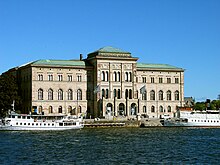Architecture of Sweden
| Part of a series on the |
| Culture of Sweden |
|---|
 |
| People |
| Languages |
|
Folklore |
| Cuisine |
| Festivals |
| Art |
| Literature |
| Music |
| Sport |
This article includes a list of general references, but it lacks sufficient corresponding inline citations. (May 2009) |
This article covers the architecture of Sweden from a historical perspective.
As is the norm in the history of architecture, the architectural history of a nation naturally lends itself to the history of its monuments, and to the development of that nation's institutions of power: palaces, castles, and churches. This also applies in the case of the history of architecture in Sweden. The break comes with the modern era, with the change in the role of architects in society, towards a concern with questions concerning the entire population, such as housing and the infrastructure of a social democracy.
Middle Ages

In
The advent of the Brick Gothic style brought brick to Sweden as a new building material. The cathedrals of Västerås, Strängnäs and Uppsala were all constructed of brick, whereas the cathedrals of Skara and Linköping were made of limestone.
While about 1,500 of Sweden's 4,000 churches date to the Middle Ages, very few secular buildings survive from this period. There are, however, a few burgher's houses in Stockholm and Visby, some castles, fortresses, and fortifications. The 13th century city walls around Visby are some of the best-preserved medieval city walls in Europe. The street layout of Stockholm's Old City is still medieval. In other Swedish cities secular buildings from the Middle Ages are very rare and often heavily rebuilt during the following centuries. One example of that is Skytteanum in Uppsala.

Renaissance
Baroque

After the
The 17th century also saw the founding of a number of cities. They were set out with a regular
Classicism and Empire style

In the second half of the 18th century, particularly after the coup of
After the Napoleonic Wars and the loss of Finland, national building activity was concentrated within the military sector. The Karlsborg Fortress and the Göta Canal, employing 60,000 men in a 23-year period, were the largest Swedish building projects of all time. The leading architect of the first half of the 19th century was also a soldier, Colonel Fredrik Blom, he designed a series of barracks and also the classically styled Skeppsholmen Church in Stockholm and, as the house architect to the royal family, he built the Rosendal Palace.
Revivalism

In the second half of the 19th century the industrialisation of Sweden began. The population of the cities trebled in the space of a few decades. This rapid urbanisation lead to prolific construction activity: tenement houses and public buildings such as schools, hospitals, prisons, hotels, banks, market halls, theatres and churches were built. An eclectic historicism distinguishes many of the buildings. The German
National Romantic style and Jugendstil

At the end of the 19th century and the beginning of the 20th century a new generation of architects emerged who turned away from historicism and classicism. On the one hand they absorbed influences from abroad, e.g. the

Modern and postmodern

The Stockholm Exhibition for Industry, Arts and Crafts 1930 helped Functionalism break-through in Sweden. In the forthcoming years—particularly in housing—this was to become the dominant ideology. A typical example of the strong link between Functionalism and the political left is the Kvarnholmen quarter in Nacka, designed in the 1930s by the architecture department of the Consumer Cooperative which was founded in 1924 as the first collectively organised architects practice.[citation needed]
Despite these initiatives, housing standards in Sweden were low. After the
The 1973 oil crisis put an end to the Million Programme. Even before this, the programme was receiving vociferous criticism against the pattern book architecture and negative social consequences which these buildings produced.[citation needed]
Out of this criticism, the term postmodern emerged in Sweden, encompassing a variety of different trends. A rich use of form developed that had not been seen since the National Romantic Style. One of the most important exponents of postmodernism in Sweden was the British-born Ralph Erskine. Today, architecture in Sweden is being defined by such architects as Gert Wingårdh, who started as a postmodernist, but is known to pick up new trends (the works show influences from ecological design as well as Minimalism, High-tech, Expressionism, and Neofunctionalism).[citation needed]
See also
- List of historic buildings in Sweden
- Listed buildings in Sweden
- Architecture of Stockholm
- Decorated Farmhouses of Hälsingland
References
- ^ "Architecture - SWEDEN.SE". www.sweden.se. Archived from the original on 26 November 2006. Retrieved 6 June 2022.
- August Hahr, Architecture in Sweden: A survey of Swedish architecture throughout the ages and up to the present day. Bonniers, Stockholm, 1938.
- Claes Caldenby (Editor), Sweden: 20th-Century Architecture. Prestel, Berlin, 1998.
- Some material translated from the German Wikipedia article de:Schwedische Architektur.
- Architecture in Sweden: https://web.archive.org/web/20061126153707/http://www.sweden.se/templates/cs/FactSheet____14340.aspx
